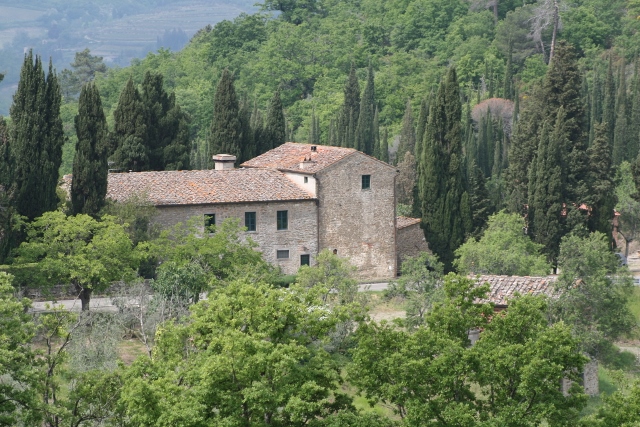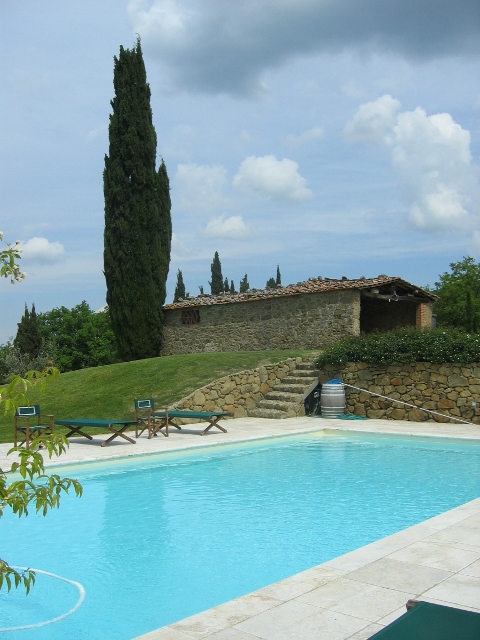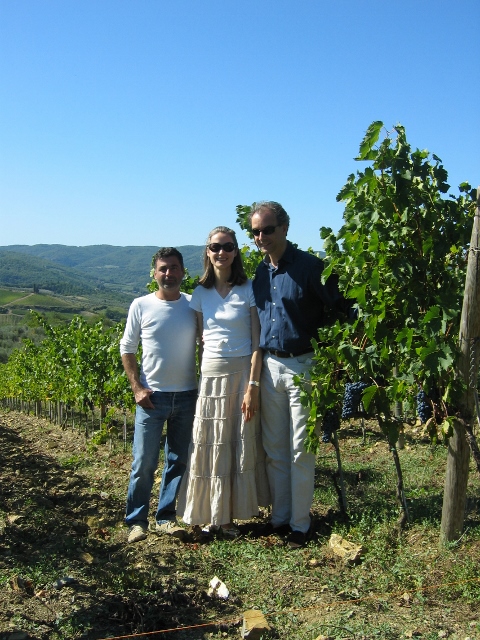- Home
- Planet Wine Blog
- A Chianti Classic Steeped in Artistic Heritage
A Chianti Classic Steeped in Artistic Heritage
Posted by on

This is why I am in the wine game – the opportunity to mix business and pleasure and to develop great friendships. When I visit Tenuta Di Riseccoli in the hills just 3km east of Greve and 45 minutes south of Florence, in the heart of Chianti Classico territory, I feel like I am combining all three. In fact, the Romanelli family, who’ve owned the property since the early 1900s, have made me feel incredibly welcome since my first visit in October 2002.
Riseccoli was a major catalyst in the creation of Planet Wine. A few exploratory emails to me from Benoit Faure Romanelli in March 2002 set the ball rolling. I had planned a trip to Corfu with a group of card-playing Bostonian friends that year and it was a cinch and a good excuse to add on a week in Tuscany.

That was the first of regular visits over the years, and the customary warm Riseccoli welcome is helped by the fact that I usually stay in one of the two beautifully restored case coloniche, or traditional farmhouses, a short walk away from the winery and the cellar door, that afford spectacular views across the distinctive Tuscan countryside as far as the Apennine mountains in the distance. The stone villas each boast a large swimming pool and expansive gardens that flow into the vineyards, and are rented out as ‘Agriturismo’ villas. (Contact us for more information about renting them.)
Florentine sculptor Romano Romanelli acquired the 17th century country house and surrounding grounds, just 35km south of that city, in 1902. Third in a line of renowned artists and sculptors, Professor Romanelli was a member of the prestigious Florence Academy of Arts and his works can still be seen in public spaces in Rome, Florence and other cities in Italy, and in museums around the world. And outside of art, Romanelli had always held a keen interest in agriculture and winemaking.
The property was a working farm when he took it over, with olive groves and orchards as well as vineyards. Initially, wine was made solely for the private consumption of the family and their closest friends in Florence, but Romanelli soon took to modernising the estate, adopting the latest viticultural and winemaking methods of the time, and Riseccoli rapidly became known for its quality wines, first in Tuscany (visitors to the present winery can see the awards the estate received dating as far back as 1927) and then beyond Italy's borders.
For much of the latter part of the 20th century and the start of the 21st, it was Romanelli’s daughter Illaria and her late French husband Arnaud Faure who kept up the family tradition at Tenuta Di Riseccoli, and now the baton has been passed to their four sons, with Benoit Faure-Romanelli being the driving force. Their ongoing dedication to maintaining the family legacy and producing outstanding wines has positioned the small-scale estate as one of the most acclaimed in the Chianti Classico sub-region of Tuscany.
The family and their team have carried out several major transformations to the estate – restructuring the vineyards, improving the clonal selection and diversifying into other grape varieties. They have also acquired and replanted new vineyards and upgraded the winemaking techniques and cellar equipment. But they still maintain an artisanal approach to winemaking and take advantage of the varying climate conditions of the region to let each vintage reveal its own unique expression of the intrinsic qualities of Riseccoli’s terroir.
One of their most adventurous initiatives has been the planting of petit verdot grapes for the crafting of a single varietal wine. They ran into some bureaucratic issues for naming the wine Petit Verdot and, logically and tongue-in-cheek, it is now called Piccolo Verdot and is receiving rave reviews, particularly in the UK.
About 25 hectares of Riseccoli’s land is in production, mostly planted to sangiovese (with smaller crops of malvasia, cabernet sauvignon, merlot and petit verdot), spread across the original family estate just east of Greve, and the more recently acquired Santo Stefano vineyards, north of the town. The original vineyards are located 500-700m above sea level, allowing for a longer ripening season. In the latter part of the year, when harvest takes place, fog is a common occurrence at Riseccoli. It is also the time of the year when wild boar (donators for the incredible local cingiale sausage) and wild deer roam the vineyards in search of sugary ripe grapes.
The remaining 115 hectares consists mostly of olive groves and forests. Tenuta Riseccoli is one of just a handful in the Chianti Classico region that also produce the highest quality extra-virgin olive oil, made with olives harvested solely by hand from their own olive groves. Their 2,500 trees are from the prized Frantoio, Moraiolo, Leccino and Pendolino varieties and are farmed with traditional organic methods.

But back to the wine – while sangiovese provides the backbone to Riseccoli’s Chianti Classico and also to their range of Tuscan red Indicazione Geografica Tipica (IGT) wines, the family’s French influence (father Faure’s origins were in Bordeaux) allows them to use French grape varieties with easy confidence, resulting in some appealing blends (less than 15% of cabernet sauvignon and merlot in the Chianti Classico and Riserva, and larger amounts for the IGT cuvées).
Yields for the sangiovese grapes are kept at the lowest level (40 to 45hl/ha) in the Chianti Classico area, enhancing the complexity of fruit in their wines. The well-drained soils, consisting essentially of galestro and clay sediment, add distinctive terroir characteristics.
Riseccoli’s full range presently comprises five reds, from the entry level fruit-forward Rinascita through to their cult Super Tuscan Saeculum, and the legendary dessert wine, Vin Santo. Bunches of Malvasia grapes are harvested for this, and hung on wires in small stone buildings with air bricks. The grapes are allowed to shrivel for weeks. After that, the wine is placed in small – 25 or 50 litre – barrels which are wax-sealed and placed in the attic to ferment and age for an additional 2-3 years. The resulting wine is expensive but worth the wait and the price!
 The family approach to the business doesn’t end with the Faure-Romanellis – three members of another local family, the Barbieris, also play an integral part. Highly respected agronomist Valerio has planted the majority of the Riseccoli vineyards, his daughter Elisabetta is the consulting winemaker and niece Serena is responsible for administration and shipping, as well as the tasting room. Cellarmaster Simone Franconi is from the nearby ancient hilltop village of Montefioralle, where he produces miniscule parcels of his own excellent wines.
The family approach to the business doesn’t end with the Faure-Romanellis – three members of another local family, the Barbieris, also play an integral part. Highly respected agronomist Valerio has planted the majority of the Riseccoli vineyards, his daughter Elisabetta is the consulting winemaker and niece Serena is responsible for administration and shipping, as well as the tasting room. Cellarmaster Simone Franconi is from the nearby ancient hilltop village of Montefioralle, where he produces miniscule parcels of his own excellent wines.
The team at Tenuta di Riseccoli are an extension of my own family. I have travelled there regularly, my wider family has visited to celebrate significant birthdays and friends of mine have also been introduced to the heart and splendour of true Chianti Classico. Check it out for yourself. And check out our range of their great wines here: Tenuta di Riseccoli
 Loading... Please wait...
Loading... Please wait...










